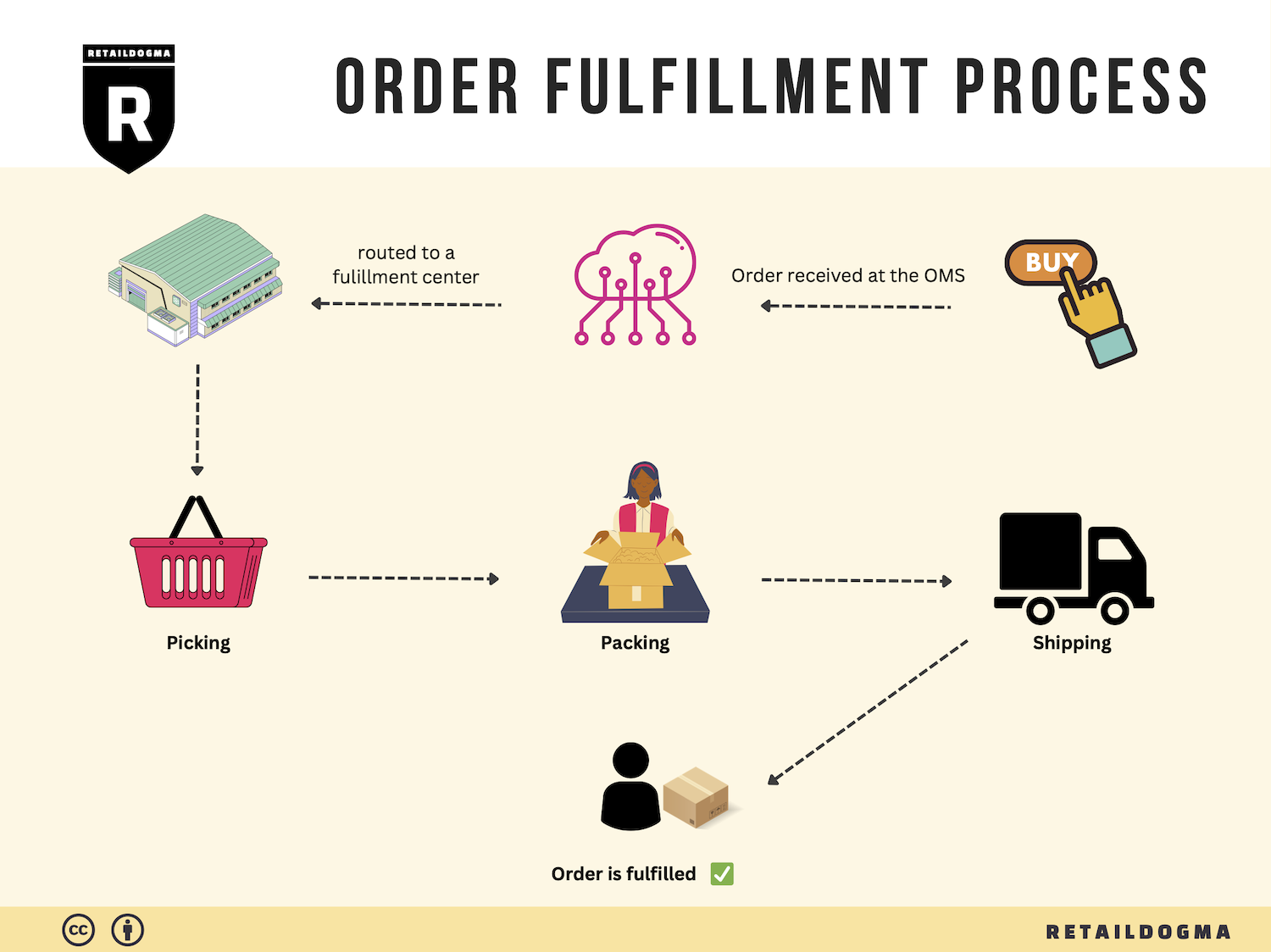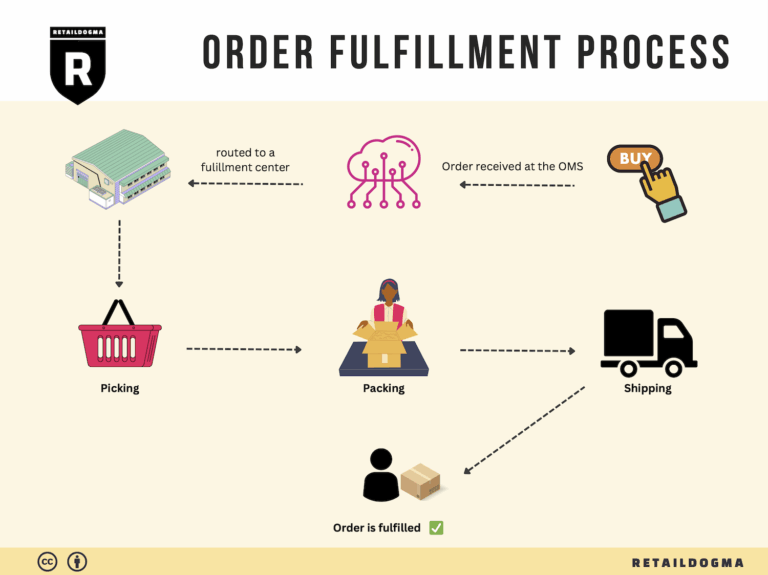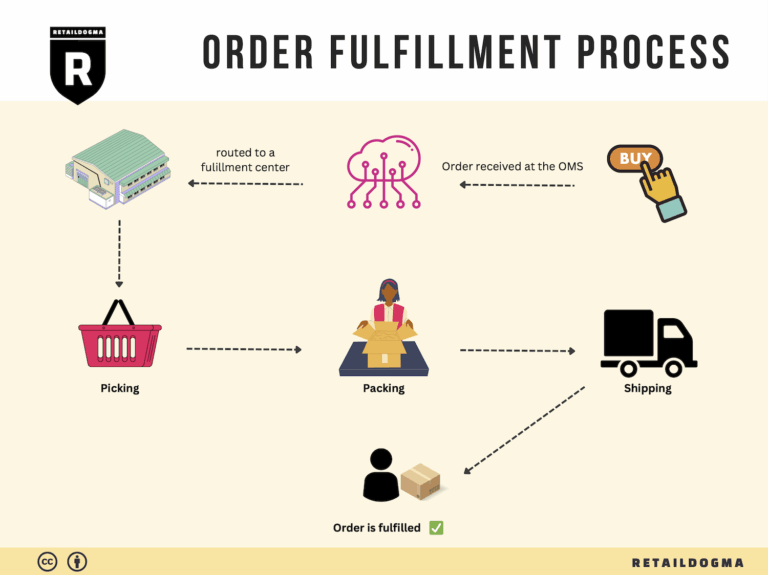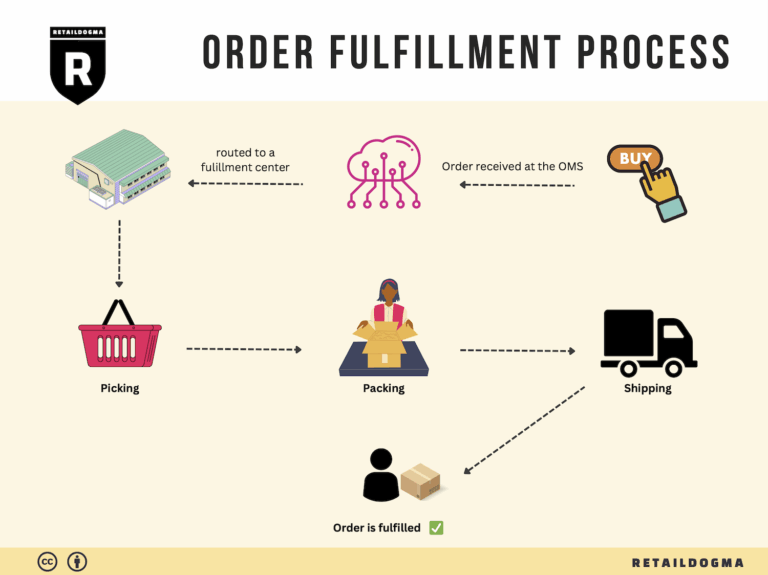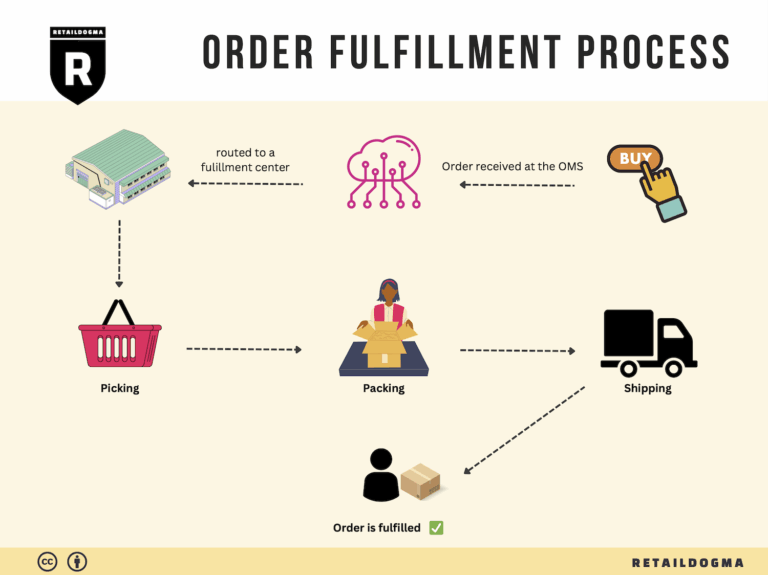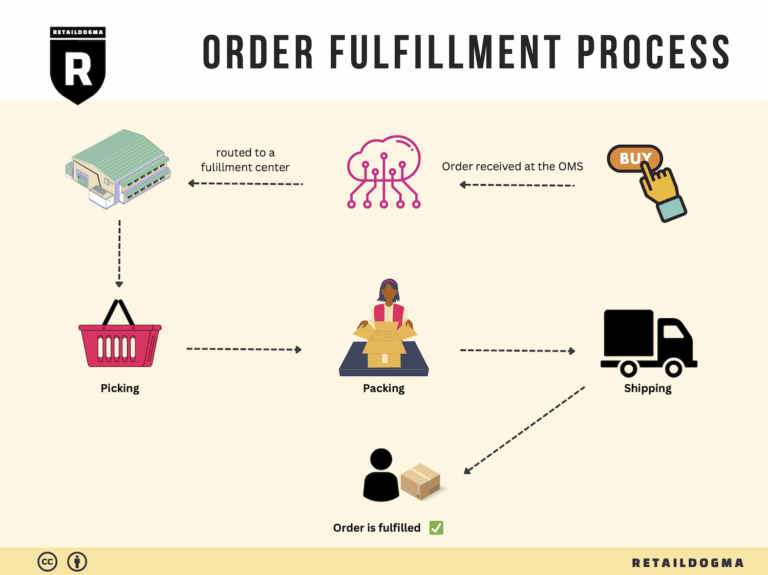How Order Fulfillment Works: A Step-by-Step Guide for Businesses
What is E-commerce Fulfillment? An Introduction for Growing Businesses
Understanding the E-commerce Fulfillment Process
As an e-commerce business owner, you may find yourself grappling with the overwhelming task of packing and shipping orders. This common pain point can consume valuable time and resources, diverting your attention from growing your business and enhancing customer experiences. Efficient fulfillment is crucial for maintaining customer satisfaction and driving repeat purchases, yet many entrepreneurs struggle to navigate the complexities of logistics.
Fulfillment, in its simplest form, is the process of getting a product from your inventory to your customer’s doorstep. This encompasses everything from receiving and storing inventory, picking and packing orders, to shipping and handling returns. As your business scales, the intricacies of this process can become increasingly challenging, making it essential to understand your options and the potential partners available to you.
This guide aims to demystify e-commerce fulfillment, presenting you with practical insights and strategies tailored for growing businesses. We will explore various fulfillment models, such as Third-Party Logistics (3PL) and Fulfillment by Amazon (FBA), each offering unique advantages depending on your business needs. By understanding these models, you can better align your operations with your growth goals.
In addition to fulfillment models, we will delve into core services that fulfillment partners typically provide. These services include inventory management, order processing, shipping options, and customer support. Knowing what to look for in these services can help you select a partner that not only meets your logistical needs but also enhances your brand’s reputation.
Choosing the right fulfillment partner is crucial for your business’s success. We will outline key criteria to consider during your selection process, including technology integration, shipping capabilities, and scalability. Understanding these factors will empower you to make informed decisions that support your long-term growth.
Finally, we will address pricing structures associated with fulfillment services. By breaking down the costs and potential hidden fees, you can better assess your budget and make strategic investments in your logistics operations.
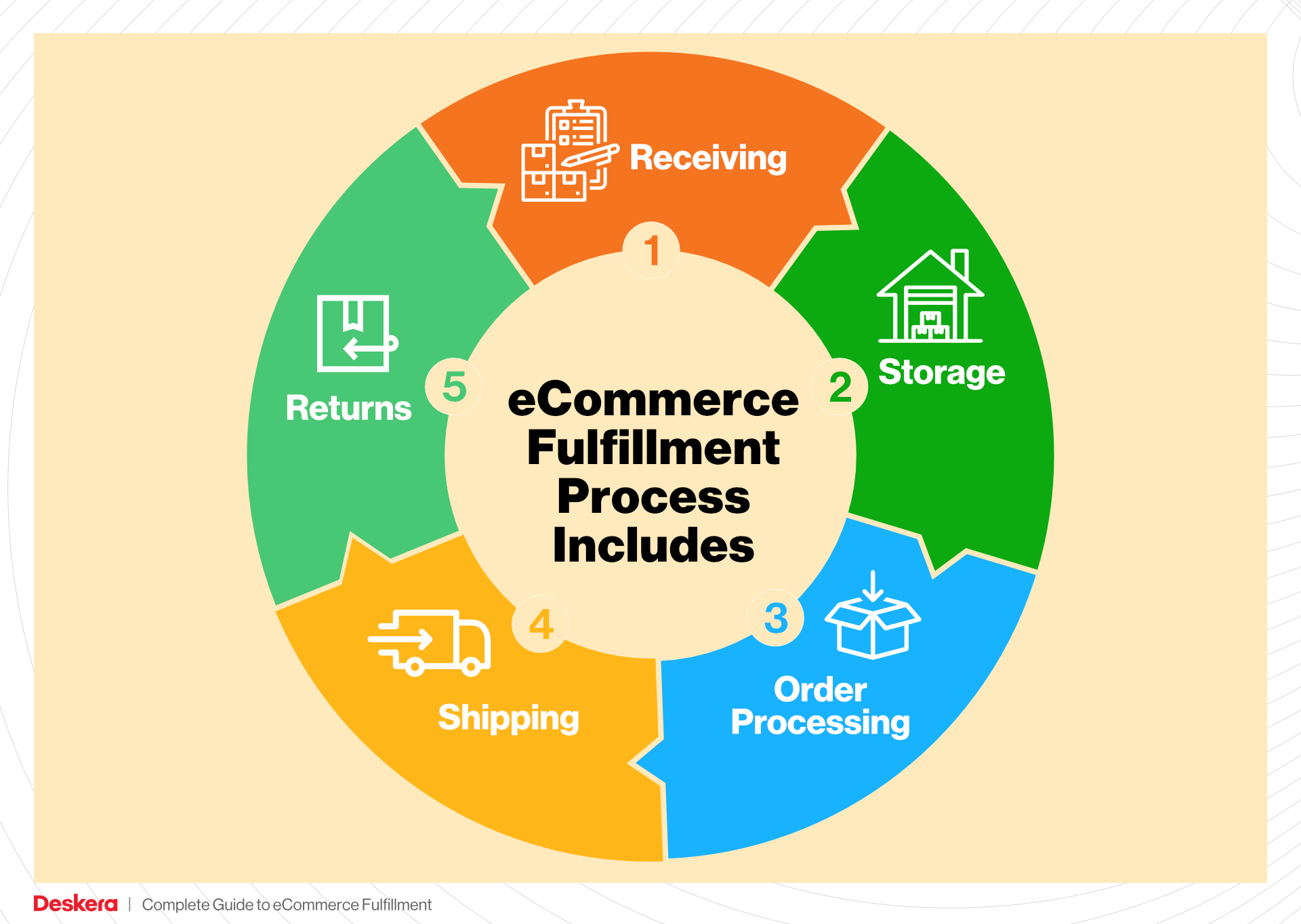
The goal of this guide is to empower you with the knowledge and tools necessary to make smart decisions about your e-commerce fulfillment strategy. By optimizing your logistics, you can focus on what truly matters: growing your business and delighting your customers.
What You’ll Learn In This Guide
- What is E-commerce Fulfillment? An Introduction for Growing Businesses
- The Order Fulfillment Process: From ‘Buy’ Button to Customer’s Door
- Comparing Fulfillment Models: In-House vs. 3PL vs. Dropshipping
- A Deep Dive into Amazon FBA: Pros, Cons, and Who It’s For
- Core Services Offered by Fulfillment Centers
- How to Choose a Fulfillment Partner: A 6-Point Checklist
- Understanding Fulfillment Pricing: A Breakdown of Common Fees
- Frequently Asked Questions (FAQs) about Fulfillment
- Conclusion: Is Outsourcing Fulfillment the Right Move for Your Business?
- Important Disclaimer
The Order Fulfillment Process: From ‘Buy’ Button to Customer’s Door
1. Receiving Inventory
The order fulfillment process begins with receiving inventory at the fulfillment center. This step involves the careful intake of products that will be sold through your e-commerce platform. Upon arrival, each item is checked against the purchase order to ensure that the correct quantities and types of products have been delivered. This is crucial for maintaining accurate inventory levels and preventing stock discrepancies.
A key term associated with this step is SKU (Stock Keeping Unit). Each product is assigned a unique SKU, which helps track inventory efficiently throughout the fulfillment process. Properly receiving inventory not only ensures that stock levels are accurate but also sets the stage for smooth operations in subsequent steps. If products are not received correctly, it can lead to issues such as stockouts or overstocking, both of which can significantly impact sales and customer satisfaction.
2. Warehouse Storage
Once the inventory has been received and verified, the next step is warehouse storage. Products are placed in designated storage locations within the fulfillment center. This step is essential for maximizing space and ensuring that items are easily accessible for order fulfillment.
Effective storage management relies on a systematic approach to organizing products, often using a location management system that allows workers to quickly find and retrieve items. Efficient storage minimizes the time spent locating products, which directly contributes to faster order fulfillment. Additionally, having a well-organized warehouse helps prevent damage to products and improves overall operational efficiency, which is crucial for scaling your business.
3. Order Picking
The order picking process is where the magic of fulfillment truly happens. When a customer places an order, the fulfillment center generates a pick list, which is a document that outlines the specific items and quantities needed to complete the order. Warehouse staff then retrieve these items from their storage locations.
Order picking is a critical step because it directly affects the speed and accuracy of order fulfillment. Efficient picking methods, such as batch picking or zone picking, can greatly reduce the time it takes to fulfill orders. Using technology, such as handheld scanners, can further enhance accuracy by ensuring that the correct items are picked. A streamlined picking process not only improves customer satisfaction through faster delivery times but also reduces operational costs by minimizing labor hours.
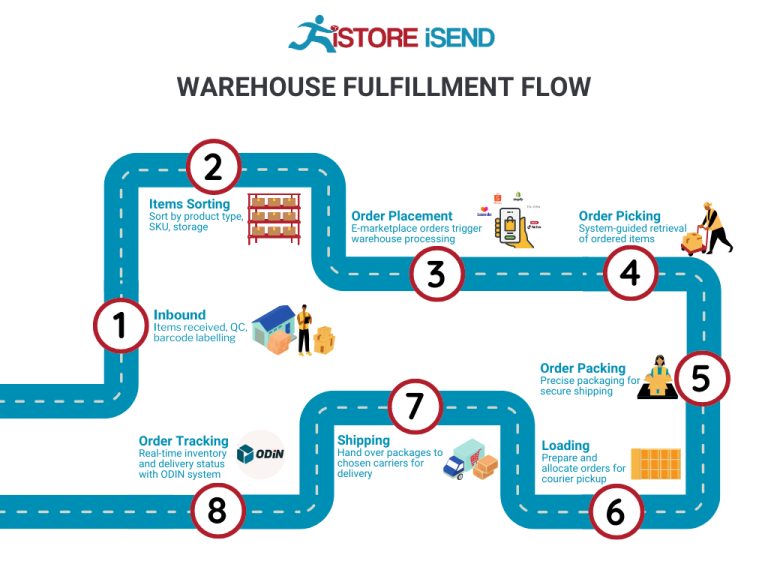
4. Order Packing
After the items have been picked, they are moved to the packing station where they are carefully packed for shipment. This step is vital for ensuring that products arrive at the customer’s doorstep in perfect condition. Proper packing techniques, such as using protective materials and appropriate box sizes, help prevent damage during transit.
A key term in this stage is packing slips, which are included in each shipment to provide customers with a detailed list of the items they ordered. This not only enhances the customer experience but also serves as a point of reference in case of returns or discrepancies. Efficient packing processes can significantly reduce shipping costs and improve delivery times, which are essential factors in retaining customers and encouraging repeat purchases.
5. Shipping & Delivery
The final step in the order fulfillment process is shipping and delivery. Once the order is packed, it is labeled and sent to a carrier for delivery. This step is crucial as it directly impacts the customer’s experience and their perception of your brand.
A key term here is last-mile delivery, which refers to the final leg of the shipping process where the package is delivered to the customer’s location. Efficient last-mile delivery is essential for achieving quick turnaround times and meeting customer expectations for fast delivery. Businesses can leverage various shipping options, including standard, expedited, and same-day delivery, to cater to different customer needs. Monitoring shipping performance through analytics can help identify areas for improvement and ensure that your fulfillment processes can scale alongside your growing business.
By understanding and optimizing each of these five steps in the order fulfillment process, e-commerce businesses can enhance operational efficiency, improve customer satisfaction, and ultimately drive growth.
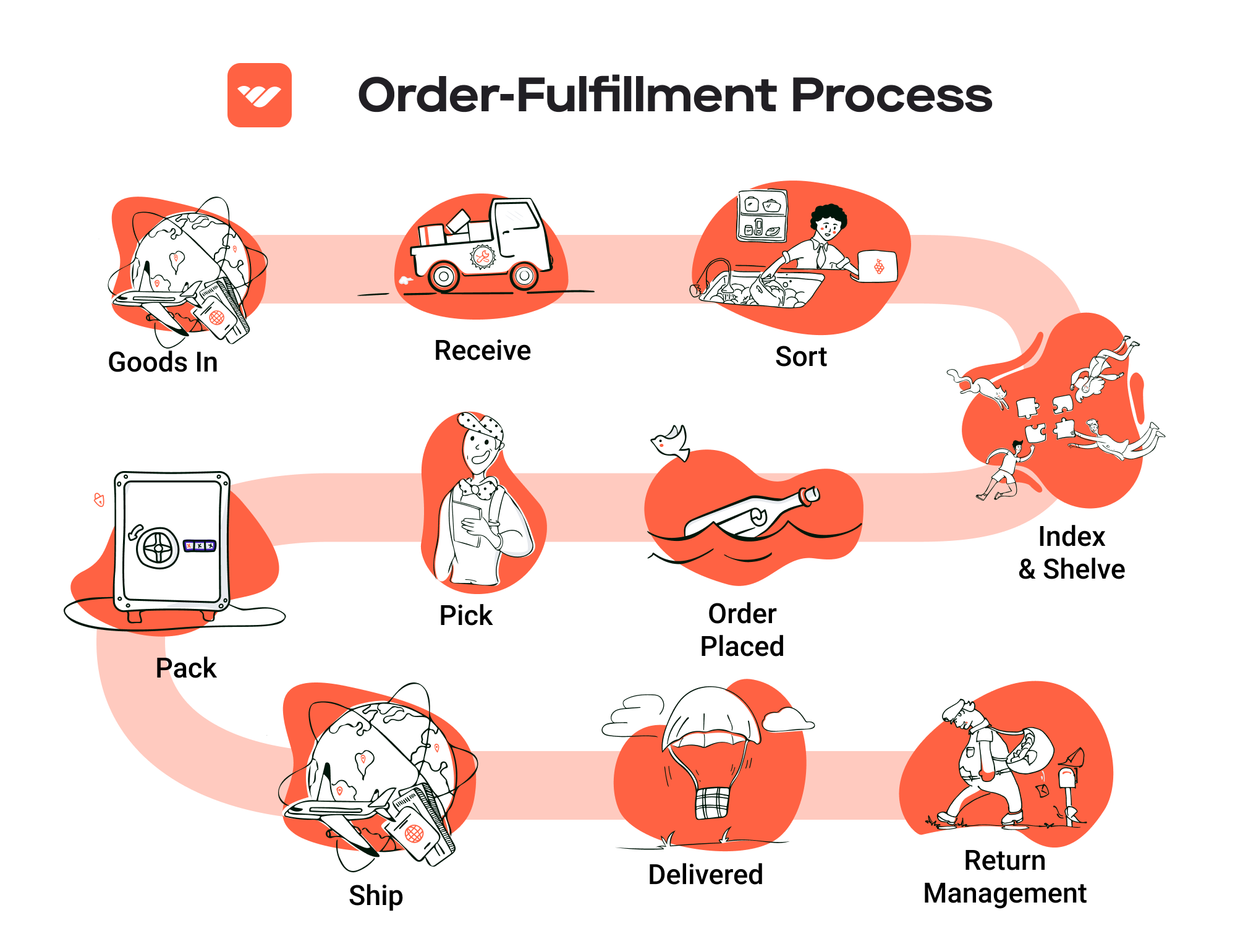
Comparing Fulfillment Models: In-House vs. 3PL vs. Dropshipping
Fulfillment Models Comparison
| Model | Who Handles Inventory | Best For (Business Stage) | Key Advantage | Key Disadvantage |
|---|---|---|---|---|
| In-House Fulfillment | Business (self-managed) | Established businesses | Complete control over operations | High overhead costs |
| Third-Party Logistics (3PL) | Third-party provider | Growing businesses | Scalability and flexibility | Less control over inventory management |
| Dropshipping | Supplier | Startups and small businesses | Low startup costs and low risk | Lower profit margins and longer shipping times |
In-House Fulfillment
In-house fulfillment involves a business managing its own inventory, warehousing, and shipping operations. This model is most suitable for established businesses with sufficient resources and a stable customer base. By controlling every aspect of the fulfillment process, companies can ensure quality and consistency in their operations. The key advantage of this model lies in the complete control it offers over inventory management, shipping speed, and customer experience. Businesses can customize their packaging and branding, enhancing the overall customer journey.
However, this model also comes with significant drawbacks. Operating a warehouse requires substantial investment in infrastructure, staffing, and technology. These overhead costs can strain cash flow, especially for businesses with fluctuating sales volumes. Additionally, as order volumes increase, businesses may struggle to scale operations efficiently, leading to potential fulfillment bottlenecks. Therefore, while in-house fulfillment provides control, it requires careful consideration of resource allocation and operational efficiency.
Third-Party Logistics (3PL)
Third-party logistics (3PL) refers to outsourcing fulfillment operations to specialized logistics providers. This model is ideal for growing businesses that need to scale quickly without the burden of managing logistics in-house. 3PL providers handle various functions, including warehousing, inventory management, order fulfillment, and shipping. By leveraging a 3PL, businesses can access advanced logistics technologies and expertise, allowing them to focus on core operations such as marketing and product development.
One of the significant advantages of using a 3PL is scalability. As businesses grow, 3PL providers can easily adjust to increased order volumes, seasonal fluctuations, or geographical expansions without the need for businesses to invest in additional infrastructure. However, this flexibility comes at a cost: businesses may experience reduced control over their inventory and fulfillment processes. This could lead to challenges in maintaining brand consistency and quality assurance. Moreover, the reliance on a third-party provider introduces risks related to service quality and communication, which can impact customer satisfaction.
Dropshipping
Dropshipping is a fulfillment model where the retailer does not hold inventory but instead partners with suppliers who ship products directly to customers. This model is particularly appealing for startups and small businesses, as it minimizes upfront investment and operational risk. Entrepreneurs can launch their e-commerce stores without the burden of managing inventory or warehousing, allowing them to focus on marketing and customer acquisition.
The key advantage of dropshipping is its low barrier to entry. Business owners can experiment with different products and markets without committing significant capital to inventory. However, dropshipping also has notable disadvantages. Profit margins tend to be lower than in-house fulfillment or 3PL models, as suppliers often charge higher prices for their services. Additionally, shipping times may be longer, especially if products are sourced from overseas suppliers, which can lead to customer dissatisfaction. The lack of control over inventory and fulfillment processes can also pose challenges in maintaining quality and consistency, making it essential for dropshippers to choose reliable suppliers carefully.
Conclusion
Selecting the right fulfillment model is crucial for e-commerce businesses aiming to scale effectively. Each model—In-house fulfillment, 3PL, and dropshipping—has its unique advantages and challenges. Understanding these nuances allows business owners and operations managers to make informed decisions that align with their current business stage, resources, and long-term goals. By carefully weighing the pros and cons of each model, e-commerce entrepreneurs can optimize their fulfillment strategies, enhance customer satisfaction, and drive sustainable growth.
A Deep Dive into Amazon FBA: Pros, Cons, and Who It’s For
Understanding Fulfillment by Amazon (FBA)
Fulfillment by Amazon (FBA) is a service that allows sellers to utilize Amazon’s extensive logistics network for storing, packing, and shipping their products. By leveraging Amazon’s fulfillment centers, sellers can streamline their operations and focus on growing their businesses while Amazon takes care of the logistics. This program integrates seamlessly with Amazon Seller Central, enabling sellers to manage their inventory and orders efficiently.
When a seller enrolls in FBA, they send their products to Amazon’s fulfillment centers, where these items are stored until an order is placed. Once an order is received, Amazon handles the picking, packing, and shipping of the product directly to the customer. This process not only simplifies logistics but also enhances the seller’s visibility on the platform, often leading to increased sales.
How FBA Works
-
Inventory Management: Sellers send their products to Amazon’s fulfillment centers. They can monitor their inventory levels in real-time via the Seller Central dashboard, which also provides insights into sales performance.
-
Order Fulfillment: When a customer places an order, Amazon picks the product from its warehouse, packs it, and ships it directly to the customer. This is typically done using Amazon’s renowned logistics network, ensuring fast delivery times.
-
Customer Service and Returns: Amazon manages customer service inquiries and handles returns for FBA orders. This feature allows sellers to focus on other aspects of their business, knowing that customer service is being managed by a trusted entity.
-
Prime Eligibility: Products fulfilled by Amazon are automatically eligible for Amazon Prime, making them more attractive to a significant segment of customers who prioritize fast, free shipping.
Pros of Using FBA
-
Prime Eligibility: FBA products are eligible for Amazon Prime, giving sellers access to millions of Prime members. This can significantly enhance product visibility and increase sales.
-
Customer Trust: Leveraging Amazon’s reputation for reliability and customer service can enhance seller credibility. Customers often feel more secure purchasing products that are fulfilled by Amazon due to the platform’s established service standards.
-
Multi-Channel Fulfillment: FBA allows sellers to fulfill orders not only from Amazon but also from other sales channels, including their own websites. This flexibility can streamline operations and improve overall logistics management.
-
Scalability: FBA is designed to scale with your business. As your sales grow, Amazon can handle increased order volumes without requiring significant changes in your operational setup.
-
Time Savings: By outsourcing logistics to Amazon, sellers can save time on packing and shipping, allowing them to focus on marketing, product development, and customer engagement.
Cons of Using FBA
-
High Fees: FBA comes with various fees, including storage fees for inventory and fulfillment fees per order. For some sellers, particularly those with low-margin products, these costs can eat into profits significantly.
-
Strict Inventory Rules: Amazon imposes strict guidelines regarding inventory management. Sellers must adhere to these rules, including limits on the quantity of items stored in fulfillment centers, which can be challenging for some businesses.
-
Commingling Risks: FBA operates on a commingling model, where inventory from different sellers is stored together. This can lead to issues if a customer receives a product that is not yours, or if there are discrepancies in inventory tracking.
-
Loss of Control: By using FBA, sellers hand over control of the fulfillment process to Amazon. This can be a disadvantage for those who prefer to manage their logistics directly.
-
Variable Shipping Times: While Amazon is known for its fast shipping, there can be instances where delays occur, particularly during peak shopping seasons. These delays can affect customer satisfaction and seller ratings.
Who is FBA Best For?
Fulfillment by Amazon is particularly well-suited for:
-
Small to Medium-Sized Businesses: Companies that lack the infrastructure or resources to manage logistics can benefit greatly from FBA, allowing them to compete on a level playing field with larger businesses.
-
E-commerce Entrepreneurs: New sellers looking to establish their brand without the burden of logistics management can use FBA to streamline their operations and focus on growth.
-
Businesses with High Sales Volumes: Sellers with significant inventory turnover can find FBA advantageous due to its scalable nature, allowing them to handle increased demand efficiently.
-
Multi-Channel Retailers: Brands selling on multiple platforms can leverage FBA to fulfill orders from various sales channels, simplifying logistics and improving customer experience.
-
Brands Seeking Prime Visibility: Sellers looking to tap into the lucrative Prime customer base will find that FBA enhances their product visibility and sales potential.
In conclusion, while FBA offers significant advantages in terms of logistics management and customer trust, it also comes with its own set of challenges, particularly regarding fees and inventory control. Each seller should carefully evaluate their specific needs and operational capabilities before deciding whether to adopt FBA as part of their e-commerce strategy.
Core Services Offered by Fulfillment Centers
Inventory Management & Warehousing
Inventory management and warehousing form the backbone of any fulfillment operation. Fulfillment centers provide businesses with dedicated storage space for their products, allowing them to stock various items without the need for extensive warehouse infrastructure. This service typically includes advanced inventory tracking systems that enable real-time monitoring of stock levels, locations, and movements within the warehouse.
Benefits:
1. Cost Efficiency: By utilizing a fulfillment center, e-commerce businesses can significantly reduce overhead costs associated with maintaining their own warehouse. This includes savings on rent, utilities, and staffing.
2. Scalability: As sales fluctuate, fulfillment centers allow businesses to scale their inventory up or down based on demand without the commitment of long-term leases or investments in physical space.
3. Enhanced Visibility: With sophisticated inventory management systems, businesses gain insights into stock levels, which aids in demand forecasting and replenishment planning. This reduces the risk of stockouts and excess inventory.
Pick and Pack Services
Pick and pack services are crucial for the efficient processing of customer orders. This service involves selecting (picking) the right products from the warehouse and preparing them for shipment (packing). Fulfillment centers employ trained staff and automation to ensure that orders are picked accurately and packed securely.
Benefits:
1. Speed and Accuracy: Fulfillment centers leverage technology and trained personnel to streamline the picking and packing process, leading to faster order fulfillment and reduced errors.
2. Customized Packaging: Many fulfillment centers offer options for branded packaging or special packing materials, enhancing the unboxing experience for customers and reinforcing brand identity.
3. Order Consolidation: For businesses with multiple product lines, fulfillment centers can consolidate orders from various suppliers, reducing shipping costs and simplifying logistics.
Kitting and Assembly
Kitting and assembly services involve grouping various products together into a single package or preparing products for sale as a set. This can include assembling items that require assembly before they are shipped, such as furniture, or creating promotional bundles that combine multiple products.
Benefits:
1. Enhanced Product Offerings: Kitting allows e-commerce businesses to create unique product offerings that can attract customers. For instance, bundling complementary products can increase average order value and boost sales.
2. Time Savings: By outsourcing kitting and assembly, businesses can focus on their core competencies, such as marketing and customer service, rather than spending time on manual assembly.
3. Improved Inventory Management: Kitting can help optimize inventory levels by combining slow-moving items with popular products, thus reducing excess stock and improving cash flow.
Returns Management (Reverse Logistics)
Returns management, also known as reverse logistics, is the process of handling product returns efficiently. Fulfillment centers provide services that streamline the returns process, including receiving returned items, inspecting them, restocking, and processing refunds or exchanges.
Benefits:
1. Customer Satisfaction: A well-managed returns process enhances customer satisfaction and loyalty. Fulfillment centers often handle returns quickly and efficiently, making it easy for customers to return products.
2. Data Insights: Returns management provides valuable data on customer preferences and product issues. Analyzing this data helps businesses improve their products and services while reducing return rates.
3. Cost Recovery: By efficiently processing returns, fulfillment centers can help businesses recover value from returned items, whether through resale, refurbishment, or recycling, thus minimizing losses associated with returns.
Conclusion
In summary, leveraging the core services offered by fulfillment centers can significantly enhance the operational efficiency and scalability of an e-commerce business. From inventory management to returns processing, these services provide essential support that allows businesses to focus on growth and customer satisfaction. By choosing a fulfillment partner strategically, e-commerce owners can optimize their logistics, reduce costs, and ultimately drive sales.
How to Choose a Fulfillment Partner: A 6-Point Checklist
Location & Warehouse Network
Importance:
The geographical location of your fulfillment partner’s warehouses is crucial for optimizing shipping times and costs. A well-placed network can ensure faster delivery to your customer base, which is vital in today’s e-commerce environment where consumers expect quick shipping.
Questions to Ask:
– Where are your warehouses located, and how does this align with my target market?
– Do you have multiple fulfillment centers to support faster shipping options?
– Can you provide insights into shipping times for different regions?
– How do you handle shipping during peak seasons or unexpected demand spikes?
Technology & Integrations
Importance:
In an increasingly digital marketplace, the technology a fulfillment partner employs can significantly impact your operational efficiency. An advanced fulfillment system allows for seamless integration with your e-commerce platform, real-time inventory tracking, and automated order management.
Questions to Ask:
– What technology do you use for inventory management and order fulfillment?
– How do you integrate with major e-commerce platforms (e.g., Shopify, Amazon, WooCommerce)?
– Can you provide real-time tracking and reporting features?
– What measures are in place for data security and compliance?
Specializations (e.g., cold storage, oversized items)
Importance:
Depending on your product offerings, you may require specialized fulfillment services. If your business deals in perishable goods, fragile items, or oversized products, it’s essential to choose a partner with the necessary expertise and facilities.
Questions to Ask:
– Do you have specialized facilities for my product type (e.g., climate-controlled storage for perishables)?
– What experience do you have handling products similar to mine?
– How do you ensure the safe handling and storage of specialized items?
– Can you accommodate unique packaging requirements for my products?
Scalability & Capacity
Importance:
As your business grows, your fulfillment needs will evolve. A capable fulfillment partner should be able to scale operations in line with your business growth, ensuring you can meet increasing demand without compromising service quality.
Questions to Ask:
– How do you manage capacity during peak seasons?
– What is your process for scaling operations if my order volume increases significantly?
– Can you provide examples of how you have supported businesses through growth phases?
– What are your limitations regarding storage space and order processing capabilities?
Pricing and Contracts
Importance:
Understanding the pricing structure and contract terms is essential to avoid unexpected costs that could eat into your margins. Transparent pricing models can help you budget effectively and assess the overall value of the partnership.
Questions to Ask:
– Can you explain your pricing model? Are there any hidden fees (e.g., storage fees, pick and pack fees)?
– What are the terms of the contract? Are there any penalties for early termination?
– Do you offer volume discounts or incentives for long-term contracts?
– How often do you review pricing, and what factors influence any changes?
Customer Support & Reviews
Importance:
Responsive customer support is critical for resolving issues quickly and maintaining smooth operations. Furthermore, reviews and testimonials can provide insight into the reliability and quality of service offered by the fulfillment partner.
Questions to Ask:
– What level of customer support do you offer (e.g., dedicated account manager, 24/7 support)?
– How do you handle customer complaints or issues with order fulfillment?
– Can you provide references or case studies from current or past clients?
– What are common feedback themes from your clients regarding your services?
Conclusion
Choosing the right fulfillment partner is a pivotal decision that can significantly impact your e-commerce success. By carefully evaluating potential partners based on the above checklist, you can ensure that you select a 3PL that aligns with your business goals, enhances your operational efficiency, and ultimately drives customer satisfaction. Always remember to conduct thorough due diligence and consider not only the immediate needs but also the long-term implications of your choice.
Understanding Fulfillment Pricing: A Breakdown of Common Fees
Initial Setup Fees
When you begin using an Amazon fulfillment center, the first cost you might encounter is the initial setup fee. This fee typically covers the onboarding process, which includes account setup, integration with your e-commerce platform, and initial training on using the Fulfillment by Amazon (FBA) system. Depending on the complexity of your product offerings and the specific services you require, setup fees can range from a few hundred to several thousand dollars. Some fulfillment centers may waive these fees for larger accounts or long-term commitments, so it’s worth negotiating this aspect during your discussions.
Receiving Fees
Once your products are ready to be sent to the fulfillment center, you will incur receiving fees. This fee is charged for the process of checking in and storing your inventory upon arrival at the fulfillment center. The fee is typically calculated per shipment and can vary based on the volume and complexity of the items received. For example, if you send multiple pallets of goods, you may pay a lower rate per pallet compared to smaller, less frequent shipments. It’s important to ensure that your products are properly labeled and packaged to minimize potential additional fees due to discrepancies during the receiving process.
Storage Fees (per pallet/bin)
After your products are received, you will be charged storage fees based on the amount of space your inventory occupies within the fulfillment center. These fees are usually calculated on a monthly basis, either per pallet or per bin, depending on how the fulfillment center organizes its storage. Rates can vary significantly depending on the location of the fulfillment center and the time of year; for instance, fees may increase during peak seasons like the holidays when demand is high. Understanding the storage fee structure can help you manage your inventory levels effectively and avoid unnecessary costs. It’s advisable to keep your stock levels optimized to prevent incurring long-term storage fees.
Pick & Pack Fees (per item/order)
The pick & pack fee is a crucial component of fulfillment pricing. This fee is charged for the labor involved in retrieving items from storage and packing them for shipment. Typically, this fee is calculated on a per-item or per-order basis, depending on how many items are included in an order. For instance, if you sell a product that requires multiple items to be picked and packed, the fee will reflect the total number of items handled. Some fulfillment centers offer tiered pricing, where the cost per item decreases as the volume increases, so it’s beneficial to assess how your order volumes align with these tiers.
Shipping Fees
Finally, shipping fees are incurred every time your products are sent out to customers. These fees can vary widely based on several factors, including the destination, the size and weight of the package, and the shipping method chosen (standard vs. expedited). Additionally, some fulfillment centers may offer discounts for bulk shipping or partnerships with carriers that can reduce costs. Understanding how shipping fees are calculated is crucial for pricing your products competitively while maintaining healthy margins.
Tips for Getting an Accurate Quote
To ensure you receive an accurate quote for fulfillment services, consider the following tips:
-
Provide Detailed Information: Be transparent about the types of products you sell, their dimensions, weights, and packaging requirements. This information is vital for accurate pricing.
-
Ask for Itemized Quotes: Request a breakdown of all potential fees, including initial setup, receiving, storage, pick & pack, and shipping fees. This transparency helps avoid surprises later.
-
Inquire About Volume Discounts: If you anticipate high order volumes, ask about discounts for larger shipments or long-term contracts.
-
Evaluate Additional Services: Consider whether you need extra services such as kitting, labeling, or returns processing, as these may incur additional fees.
-
Compare Multiple Fulfillment Centers: Don’t settle for the first quote you receive. Comparing multiple fulfillment options can help you find the best balance between cost and service quality.
By understanding these common fees and how they are calculated, you can make informed decisions about your fulfillment strategy and better manage your overall e-commerce costs.
Frequently Asked Questions (FAQs) about Fulfillment
1. What is an Amazon Fulfillment Center, specifically LU2?
An Amazon Fulfillment Center LU2 is a specialized warehouse facility operated by Amazon, designed to store, pick, pack, and ship products for sellers using the Fulfillment by Amazon (FBA) service. Located strategically to optimize shipping times, LU2 plays a crucial role in Amazon’s extensive logistics network, enabling fast delivery to customers.
2. How does the Fulfillment by Amazon (FBA) program work?
FBA allows sellers to store their products in Amazon’s fulfillment centers. Amazon handles the logistics, including storage, packaging, shipping, and customer service. When a customer places an order, Amazon picks the item from the fulfillment center, packs it, and ships it directly to the customer, streamlining the seller’s operations and enhancing their visibility on the platform.
3. What is the difference between a warehouse and a fulfillment center?
A warehouse primarily focuses on storing products, while a fulfillment center is designed to facilitate the entire process of order fulfillment. Fulfillment centers use advanced technology and processes to pick, pack, and ship orders efficiently, often incorporating automation and real-time inventory management to ensure swift delivery.
4. What costs are associated with using Amazon’s fulfillment services?
Costs associated with Amazon’s fulfillment services include storage fees (charged monthly based on the amount of space your products occupy), fulfillment fees (charged per unit sold, which covers picking, packing, and shipping), and additional fees for long-term storage if items remain unsold for over 365 days. It’s essential to evaluate these costs to understand the overall impact on your profit margins.
5. How can I track my inventory in Amazon Fulfillment Center LU2?
Sellers can track their inventory using Amazon Seller Central, the online dashboard that provides real-time insights into stock levels at fulfillment centers. This platform allows you to monitor inventory turnover, set alerts for low stock, and manage restocking efforts efficiently.
6. What types of products can be fulfilled through Amazon Fulfillment Centers?
Amazon Fulfillment Centers can handle a wide range of products, including consumer goods, electronics, clothing, and more. However, there are restrictions on certain items, such as hazardous materials, perishables, and products that require special handling. Sellers should review Amazon’s guidelines to ensure compliance.
7. What is a Third-Party Logistics Provider (3PL)?
A Third-Party Logistics Provider (3PL) is a service that allows businesses to outsource their logistics and fulfillment operations to a third-party company. 3PLs can manage warehousing, inventory management, order fulfillment, and shipping, providing flexibility and scalability for e-commerce businesses. Unlike FBA, 3PLs can work with various marketplaces and not just Amazon.
8. How do I create and manage my FBA shipments?
To create and manage FBA shipments, log into your Amazon Seller Central account, navigate to the Inventory section, and select ‘Manage FBA Shipments.’ From there, you can create new shipments, label your products, and print shipping labels. Amazon provides detailed instructions to ensure your shipments meet their requirements.
9. What support does Amazon provide for sellers using LU2?
Amazon offers various support options for sellers using LU2, including access to Seller Central for managing inventory, educational resources like webinars and guides, and customer service for handling fulfillment-related inquiries. Additionally, Amazon provides analytics tools to help sellers optimize their inventory and sales strategies.
10. Can I fulfill orders from my own website using Amazon Fulfillment Centers?
Yes, sellers can use Amazon’s fulfillment services to fulfill orders from their own websites through the Multi-Channel Fulfillment (MCF) program. This allows you to leverage Amazon’s logistics capabilities while maintaining your brand presence on other sales channels. You simply need to integrate your website with Amazon’s fulfillment system to start processing orders.
Conclusion: Is Outsourcing Fulfillment the Right Move for Your Business?
Evaluating the Benefits of Outsourcing Fulfillment
Outsourcing fulfillment can be a transformative decision for e-commerce businesses looking to scale. By leveraging a fulfillment service, businesses can save significant time and resources, allowing them to focus on core operations such as product development and marketing. This is particularly vital in today’s fast-paced e-commerce landscape, where timely delivery is critical to customer satisfaction and retention.
One of the standout advantages of partnering with a fulfillment center, like those in Amazon’s extensive network, is scalability. As your business grows, so do your logistics demands. Fulfillment services provide the infrastructure to handle increased order volumes without the need for substantial upfront investment in warehousing and personnel. This flexibility enables businesses to respond swiftly to market changes and seasonal demands, ensuring they remain competitive.
Moreover, fulfillment partners bring specialized expertise to the table. They are well-versed in logistics, inventory management, and shipping regulations, which can mitigate the risks associated with these complex processes. This expertise not only enhances operational efficiency but also improves customer experience through faster and more reliable shipping options.
However, selecting the right fulfillment partner is crucial for sustainable growth. It is essential to evaluate potential partners based on their technology capabilities, customer service, and alignment with your business goals. The right partner can propel your business forward, while the wrong one can hinder your progress.
Take Action: Audit Your Shipping Process
Now is the time to assess your current shipping and fulfillment processes. Conduct a thorough audit to identify inefficiencies and bottlenecks. Ask yourself: Are you meeting customer expectations for delivery speed? Are your operational costs manageable? If the answers raise concerns, it may be time to consider a fulfillment partner. By making an informed decision now, you can position your business for success in the competitive e-commerce landscape.
Important Disclaimer
⚠️ Important Disclaimer
The information in this guide is for educational purposes. Fulfillment services, pricing, and platform features change frequently. Always conduct your own due diligence and consult with providers directly before making business decisions.
